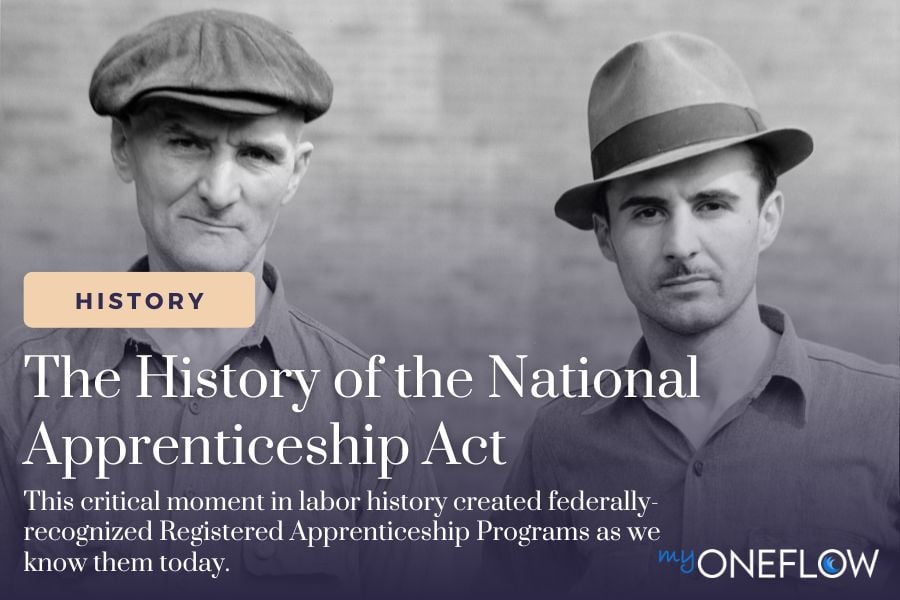10 Amazing Stats That Show the Value of Registered Apprenticeship Programs
Happy National Apprenticeship Week! This important event serves as a yearly reminder of the vital role apprenticeships play in strengthening our...

The history of apprenticeships in America is as old as the nation itself. British artisans and tradespeople came to the colonies to help build and brought their apprentices with them. These early apprenticeships involved a domestic master/apprentice relationship where the apprentice relied on their master for all their basic needs, including food and shelter. The apprentice was typically uncompensated financially but received intensive one-on-one training until they were skilled enough to start their own business.
The Industrial Revolution dramatically changed the face of work in the United States, including apprenticeships. Domestic apprenticeships began to disappear, and more apprentices were paid for their labor. However, as factory work became the norm, working conditions continued to slide. More employers sought to take advantage of their employees with long hours, unsafe working conditions, and low wages, and apprentices were no exception.
In the early 1900s, several forces were at play that led to a rapid evolution of the American workforce. The onset of World War I saw an increase in manufacturing needs. At the same time, employees and labor reformists began to organize and advocate for better working conditions and pay. This combination led to the passage of several pieces of legislation that set the groundwork for the marriage between labor, education, and governmental regulation.
The Smith-Hughes Act was passed in 1917 and provided federal funds to support vocational education. This funding supported employers and unions in creating training programs across the country. The Smith-Hughes Act also paved the way for future related laws such as the Vocational Education Act of 1963 and the Carl D. Perkins Vocational Education Act of 1984.
In 1933, President Franklin D. Roosevelt signed the National Industrial Recovery Act (NIRA) to regulate industry, protect workers, and improve the economy during the Great Depression. NIRA included historic measures such as minimum wage, limits on maximum hours worked, and child labor laws. NIRA’s National Recovery Administration collaborated with trade unions to create “industry codes” that established standards for working conditions and wages for each specific industry. For the construction industry, this included apprenticeship regulations – the first federal regulations related to apprenticeships.
However, NIRA was highly unpopular and has since been largely considered a political failure. It promoted monopolies and had no support from the business community. It created hundreds of new industry codes and prohibited thousands of business practices but lacked the leadership and proper administration to enforce them. In 1935, the Supreme Court ruled that it was unconstitutional due to an overreach of authority and struck the law down.
The Secretary of Labor at the time, Frances Perkins, created the Federal Committee on Apprenticeship to continue the labor reform that NIRA's construction industry codes started. The committee was tasked with researching and proposing standards for apprenticeship programs but lacked any authority to impose regulations.
Finally, in 1937, Roosevelt signed the National Apprenticeship Act (NAA), giving the committee authority to determine apprenticeship regulations and set standards for a federally-recognized Registered Apprenticeship Program. The bill was later expanded to give the U.S. Department of Labor authority to establish regulations as well.
Today, the NAA is administered by the Employment and Training Administration division of the Department of Labor. NAA legislation supports apprentices by setting minimum standards for Registered Apprenticeship Programs, prohibiting discrimination, and mandating incremental wage increases. Modern-day apprenticeship programs continue to be a smart investment for employers and a foundation for maintaining a healthy pipeline of skilled labor. myOneFlow is proud to support apprenticeship programs with next-gen apprenticeship management & tracking software. Contact our team to learn more!

Happy National Apprenticeship Week! This important event serves as a yearly reminder of the vital role apprenticeships play in strengthening our...
Apprenticeships have long been vital for workforce development, providing individuals with hands-on experience while addressing critical labor...

Since the pandemic, businesses have been facing an unprecedented labor shortage. As of June 2022, there were almost twice as many job openings as...